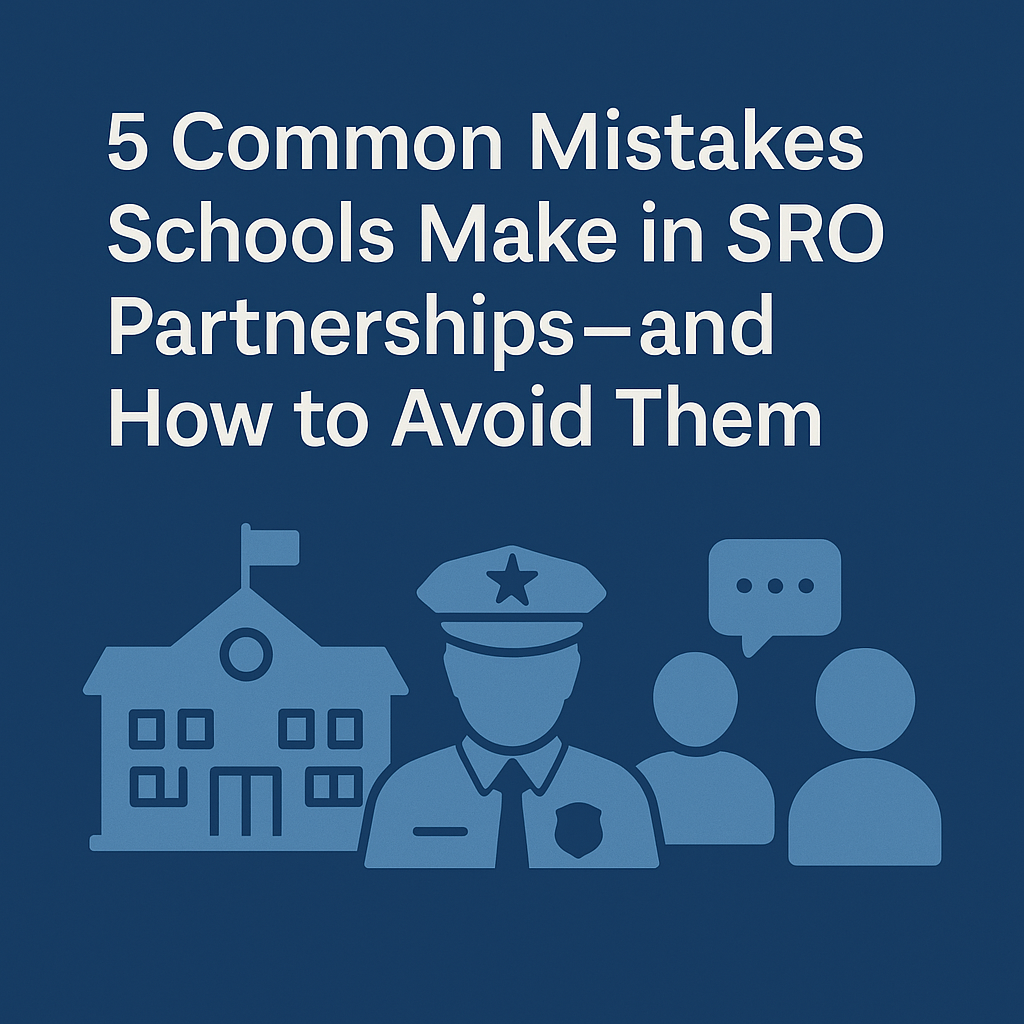5 Common Mistakes Schools Make in SRO Partnerships—and How to Avoid Them
By John Huber
A successful school resource officer (SRO) partnership is built on clarity, trust, and mutual respect. But most importantly, the core component of these partnerships is knowledge of the boundaries as outlined in the MOU. I have spoken to many SROs and school officials over the last several years who did not even know what an MOU is—much less have any direct knowledge of the specific documents that were guiding the very partnership of which they were a part.
Well-intentioned schools can make mistakes that put stress on these partnerships—sometimes permanently. Based on years of working with schools and analyzing real-world incidents, I’ve identified five recurring mistakes schools make when working with SROs. These mistakes don’t just disrupt daily operations; they can destroy public trust, expose schools to liability, and damage the very partnerships designed to protect students. In some cases, problems in the partnership can create unsafe and dangerous situations.
1. Overusing the SRO as a Disciplinarian
One of the most common and damaging errors schools make is relying on the SRO to handle routine student discipline. No matter how many times both sides say it—they still do it. Everyday incidents around the U.S. are documented when an incident goes viral that started from a situation where there was no law being broken, and the SRO should not have been involved.
SROs are not backup principals. When educators turn to officers for minor infractions—like defiance, profanity, or rule violations; they create confusion over roles and escalate situations that should remain internal. The result? Students are unnecessarily criminalized, and the officer’s core function as a safety leader is diluted.
In one case in Michigan, a student was arrested over a disciplinary matter that started with enforcement of a cellphone policy. The school’s decision to involve law enforcement where no crime occurred sent the wrong message to students, parents, and the broader community—and it damaged trust in the partnership.
2. Failing to Coordinate in High-Stress Moments
Too often, schools act independently in tense situations and bring in SROs at the last minute without a shared plan. This can lead to rushed decisions, safety breakdowns, and misaligned responses. A successful partnership relies on planning ahead—not handing off a problem when it reaches crisis mode. When there’s no coordinated response strategy, even well-trained officers can be blindsided, and safety is compromised.
In the shooting at Apalachee High in Georgia, there is still conflicting information about the timeline of events that morning. Some reports say an administrator was looking for the would-be shooter and others say it was an SRO. The SRO who was stationed at the school was not the one who eventually subdued the shooter. Different reports list different officers who dealt with the situation.
While law enforcement acted swiftly and bravely, there is still some question about the coordination between the school and the on-site SRO when the initial information was received that there was a serious potential threat.
3. Treating the SRO as a School Official
While a high-functioning partnership does mean collaboration, schools must remember that SROs operate under a separate legal and professional authority. When school administrators include SROs in decisions about student discipline or policy without clarity, they blur the lines—and risk legal consequences. Police are trained to handle crises, not to deal with students who are using cell phones or foul language.
In Rockford, Illinois, a school system is facing a lawsuit for using SROs to enforce school rules unrelated to criminal activity. Courts increasingly push back when schools treat SROs as administrators, especially if that relationship results in punitive consequences for students.
4. Assuming Community Incidents Don’t Affect the School
Schools often miscalculate the importance of their relationship with law enforcement beyond the building. What happens in the broader community—even if it doesn’t involve students or the SRO—can still shape perceptions. A lack of communication, transparency, or proactive alignment with police partners during a public crisis can lead to broken partnerships.
This played out in Lockland, Ohio, when a neo-Nazi protest and the police department’s response created a public relations crisis. Although no students were directly involved, the school district severed ties with its SRO, largely because there was no unified message or visible collaboration with the school during the incident. It was a missed opportunity for joint leadership—and the relationship suffered.
5. Inviting the SRO Across Boundaries Without Guardrails
At higher-functioning levels of partnership, it’s natural for SROs to occasionally cross into areas like student conflict mediation or policy advising. But when schools invite officers into these roles without clear boundaries, documentation, or fallback plans, they take unnecessary risks. Even well-respected SROs can inadvertently escalate a situation if the roles are not explicitly defined.
A prime example is Smithfield–Selma High School, where an SRO was assaulted while removing a student without proper support or communication from school staff. The SRO was “assisting school administrators with escorting a student to the office.” That situation escalated quickly—and avoidably—because the boundaries weren’t clearly defined.
Moving Forward: Clarity, Not Confusion
These aren’t just isolated events—they reflect a pattern of miscommunication, blurred boundaries, and inadequate planning that I’ve seen repeatedly in my work with schools across the country. The solution isn’t complicated, but it does require discipline:
- Define the SRO’s role clearly in writing and in practice.
- Train all school staff on the triad model: law enforcement, mentor, educator—not disciplinarian.
- Coordinate responses before, not during, a crisis.
- Treat public perception as part of your safety plan.
- Know when you’re inviting the SRO across the “fence”—and agree in advance when and how to retreat.
With mutual respect and intentional partnership, schools and SROs can function as true allies in creating safer, more supportive environments. But that partnership must be built on trust—and trust demands clarity, boundaries, and communication.
